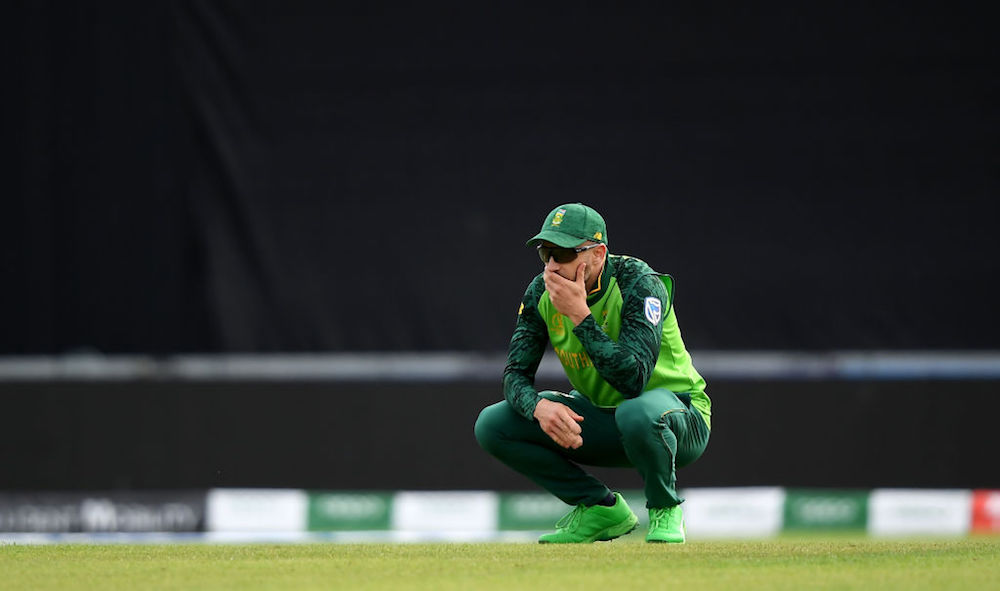Yet again South Africa were unable to get across the finishing line in a World Cup match when there was every chance of them being able to do so, writes GARY LEMKE.
It always seems to end like this for the Proteas. It’s the hope that gets to the supporters, the longest of suffering fans. But another World Cup campaign has ended in tears, rather than beers and cheers. Sure, there’s that ‘mathematical chance’ that South Africa can make the semi-finals. Which again shows the unrealistic hope that Proteas fans cling to when everything screams it’s game over.
A fourth defeat in six games – and with the only victory coming against Afghanistan, along with a rained-out no-result against West Indies when the Proteas were two wickets down inside seven overs – is a poor return from a squad which attempted to fly under the radar this time round.
And this time there were no excuses in going down to New Zealand by four wickets, with three balls of the 49 overs remaining. It doesn’t sound so bad if you’re a South African supporter, does it? Beaten by four wickets with three balls left?
In truth, this World Cup campaign was over the moment the selectors entrusted coach Ottis Gibson – the former West Indian fast bowler who has unashamedly advocated a ‘bowlers-win-matches’ process – to swim upstream with backing bowlers over batsmen for the tournament.
A day after England’s captain Eion Morgan hammered a world ODI record 17 sixes in beating Afghanistan, South Africa limped to 241 for 6 against New Zealand. And Rassie van der Dussen swiped 15 runs off the Proteas’ last over to get them to that score.
As captain Faf du Plessis admitted afterwards, that total was 20 to 30 runs short of what was par, even if the pitch was stickier and slower than the Edgbaston track which has averaged 280 in ODIs in the last four years.
Sure, sport at the highest level comes down to small margins. And, again, it was the batsmen who cost South Africa the chance to go further than the group stages in this tournament.
The simplest way of explaining that is this: While social media and statisticians were waxing lyrical about Hashim Amla being the second-fastest player (behind India’s Virat Kohli) to reach 8 000 ODI runs – a phenomenal achievement – he and Aiden Markram put South Africa’s innings into a straitjacket.
Captain Du Plessis was correct in his assessment; despite being put into bat first the Proteas were at least 20 runs light, probably 30.
In 100 balls bowled between the 16th and the 32nd over, South Africa hit five fours, four of them by Markram and one by Amla. Both scored at a strike rate of 66 balls per hundred, as seen by both of them getting to 33 off 50 balls.
As shown by Van der Dussen, who was instrumental in giving South Africa’s bowlers a target to defend with 67 off 64 balls, and David Miller, who perished for 36 off 37 balls just when he looked to be changing gear, there were runs to be made once a player got in on this pitch.
But, to score five boundaries in 100 balls from overs 16 and 32 and then having to wait another 60 balls before Van der Dussen cleared the ropes with a six for the next boundary of the innings, showed how wrong South Africa’s batsmen got things. They got bogged down by the spin of Mitchell Santner (9-0-45-1) and Colin de Grandhomme (10-0-33-1) and seemed happy to allow Matt Henry (10-2-34-0) to pile up the dot balls by bowling outside of off stump.
The bowlers were always going to struggle to contain New Zealand and at no stage of the match were South Africa favourites to win when it came to the in-play odds of the online bookies. In other words, the Proteas were always underdogs and while some fans will say ‘so close’, the facts are that they came second in a two-horse race for the fourth time in six World Cup matches.
New Zealand didn’t look like world champions-in-waiting either, although captain Kane Williamson’s unbeaten 106 to carry them home showed again what a quality player he is. England and India look the two best countries in the competition and both swatted South Africa aside with more ease than the Kiwis did.
The fielding on both sides was energetic rather than clinical, with both dropping catches and making mistakes, and poor – at this level – execution when it came to attempted run-outs and direct hits.
It was a nervy win by New Zealand against an equally nervy South Africa. Sure, the scoreline suggested it was a nail-biter and perhaps it was for some, but when it came to the quality that wins matches like these, those moments came from the Kiwis.







